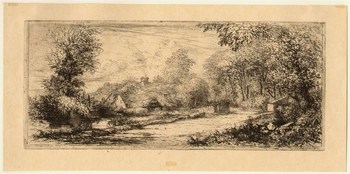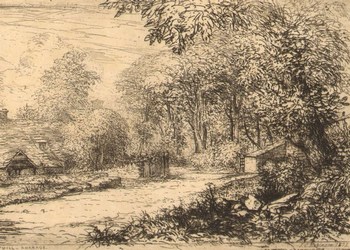|
19-20 thC. British and
American prints |
|
|
|
|
|
Sir
John Charles Robinson (British 1824-1913)
Besides an etcher with some fine
works like Corfe Castle, Sunshine after Rain, Swanage down ans Space and Light
which are entirely successful he was above all...
an art connoisseur and
collector, the son of Alfred Robinson, of Nottingham, John Charles Robinson was
born 16 December 1824 at Nottingham, where he was also educated. He was brought
up there by his grandfather, a bookseller, and, later, was sent for art-training
to the studio of Michel Martin Drolling in Paris. There he spent much time in
the Louvre, laying the foundation of his knowledge of Renaissance art. In 1847
he was appointed head master of the government school of art at Hanley,
Staffordshire. In 1852 he became first superintendent of art collections of the
South Kensington Museum, where he remained for seventeen years, and organized
the circulation of works of art among provincial institutions. Robinson's
technical knowledge and artistic appreciation of the many branches of art were
unusually wide and thorough, and his taste was in a extraordinary degree in
advance of his time. Until his resignation in 1869 he was frequently employed in
travelling for the museum in Italy and especially in Spain. With the small funds
at his disposal he was able to acquire, at what would now be considered
infinitesimal prices, a vast number of those works in marble, bronze, majolica,
and terracotta which quickly gave South Kensington a unique position at the time
among the museums of Europe. On retiring from the public service he continued
this important work as the adviser of eminent private collectors, such as Mr.
Malcolm of Poltalloch, and Sir Francis Cook. As an instance of his wise
purchases, he acquired for Sir Francis Cook in 1872 for £335 Hubert van Eyck's
The Three Maries, which in 1927 was the gem of the Flemish exhibition in London.
Robinson's own extensive collections included at one time or another, besides
paintings, drawings, and sketches, Greek gems, Renaissance jewellery, ivories,
bronzes, Oriental porcelain, French furniture, Spanish and Italian embroideries,
and ancient Coptic fabrics. From 1882 to 1901 he was surveyor of the Queen's
pictures. He was knighted in 1887 and made C.B. in 1901.
In 1866, in conjunction with the
Marquis d'Azeglio, Robinson founded the Fine Arts Club (afterwards the
Burlington Fine Arts Club), and for fifteen years acted as its honorary
secretary. He was a skillful etcher, excelling especially in his treatment of
strong effects of light, and he joined with his lifelong friend, Sir Francis
Seymour Haden, in founding the Royal Society of Painter Etchers. Unfortunately,
beyond letters and articles in The Times, Nineteenth Century, and other
journals, he left no written memorials other than catalogues of various
collections, chief of which was the admirable catalogue raisonné of the Drawings
by Michael Angelo and Raffaelle in the University Galleries at Oxford (1870). He
was a fearless and outspoken critic, who nevertheless numbered many artists and
experts among his personal friends.
Robinson married Marian Elizabeth
Newton in 1852, daughter of Edmund Newton, of Norwich, by whom he had five sons
and two daughters. She died in 1908. One of his sons is Mr Charles Newton
Robinson and another is Mr Gerald Robinson, the mezzotint engraver. For many
years he lived in Harley Street, but moved some years ago to the beautiful old
house at Swanage where he died on 20 April 1913.
|

|
|
ULWELD MILL SWANAGE - 1871
Engraved title, signature and date inside the plate border.
On laid paper with full
margins.
Perfect condition.
26,50 by 11,50 cm on plate border
15 by 30 for the sheet
Price: 125 € |
You can access larger images by clicking on the thumbnails.
Contact me for prices and availability before purchase.
Below you can access detail
images to see the quality of these works.


